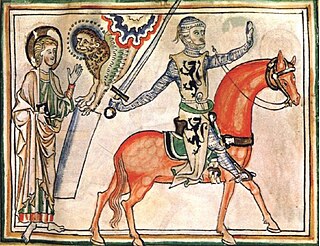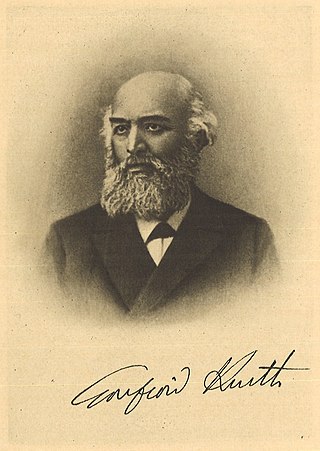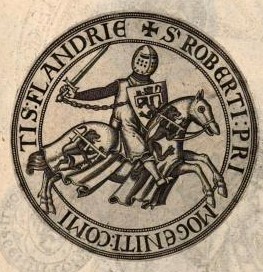Related Research Articles

For most of its history, what is now Belgium was either a part of a larger territory, such as the Carolingian Empire, or divided into a number of smaller states, prominent among them being the Duchy of Lower Lorraine, the Duchy of Brabant, the County of Flanders, the Prince-Bishopric of Liège, the County of Namur, the County of Hainaut and the County of Luxembourg. Due to its strategic location as a country of contact between different cultures, Belgium has been called the "crossroads of Europe"; for the many armies fighting on its soil, it has also been called the "battlefield of Europe" or the "cockpit of Europe".
The Union of Utrecht was a treaty signed on 23 January 1579 in Utrecht, Netherlands, unifying the northern provinces of the Netherlands, until then under the control of Habsburg Spain.

Leopold I was the first King of the Belgians, reigning from 21 July 1831 until his death in 1865.

Henri Pirenne was a Belgian historian. A medievalist of Walloon descent, he wrote a multivolume history of Belgium in French and became a prominent public intellectual. Pirenne made a lasting contribution to the study of cities that was a controversial interpretation of the end of Roman civilization and the rebirth of medieval urban culture. He also became prominent in the nonviolent resistance to the Germans who occupied Belgium in World War I.

The Southern Netherlands, also called the Catholic Netherlands, were the parts of the Low Countries belonging to the Holy Roman Empire which were at first largely controlled by Habsburg Spain and later by the Austrian Habsburgs until occupied and annexed by Revolutionary France (1794–1815).

Floris V reigned as Count of Holland and Zeeland from 1256 until 1296. His life was documented in detail in the Rijmkroniek by Melis Stoke, his chronicler. He is credited with a mostly peaceful reign, modernizing administration, policies beneficial to trade, generally acting in the interests of his peasants at the expense of nobility, and reclaiming land from the sea. His dramatic murder, said by some to have been arranged by King Edward I of England and Guy, Count of Flanders, made him a hero in Holland.

Margaret, often called Margaret of Constantinople, ruled as Countess of Flanders during 1244–1278 and Countess of Hainaut during 1244–1253 and 1257–1280. She was the younger daughter of Baldwin IX, Count of Flanders and Hainaut, and Marie of Champagne.

The Belgian Revolution was the conflict which led to the secession of the southern provinces from the United Kingdom of the Netherlands and the establishment of an independent Kingdom of Belgium.

Guy of Dampierre was the Count of Flanders (1251–1305) and Marquis of Namur (1264–1305). He was a prisoner of the French when his Flemings defeated the latter at the Battle of the Golden Spurs in 1302.

Godefroid Kurth (1847–1916) was a Belgian historian and pioneering Christian democrat. He is known for his histories of the city of Liège in the Middle Ages and of Belgium, his Catholic account of the formation of modern Europe in Les Origines de la civilisation moderne, and his defence of the medieval guild system.

The Flemish peasant revolt of 1323–1328, sometimes referred to as the Flemish Coast uprising in historical writing, was a popular revolt in late medieval Europe. Beginning as a series of scattered rural riots in late 1323, peasant insurrection escalated into a full-scale rebellion that dominated public affairs in Flanders for nearly five years until 1328. The uprising in Flanders was caused by excessive taxations levied by the Count of Flanders Louis I and by his pro-French policies. The insurrection had urban leaders and rural factions, which took over most of Flanders by 1325.

Robert III, also called Robert of Béthune and nicknamed The Lion of Flanders, was the Count of Nevers from 1273 and Count of Flanders from 1305 until his death.
François Louis Ganshof was a Belgian medievalist. After studies at the Athénée Royal, he attended the University of Ghent, where he came under the influence of Henri Pirenne. After studies with Ferdinand Lot, he practiced law for a period, before returning to the University of Ghent. Here, he succeeded Pirenne in 1930 as professor of medieval history, after Pirenne left the university as a result of the enforcement of Dutch as language of instruction. He remained there until his retirement in 1961.

The Matins of Bruges was the nocturnal massacre of the French garrison in Bruges and their Leliaards supporters, a political faction in favour of French rule, on 18 May 1302 by the members of the local Flemish militia. It has been named "Matins" in analogy to the Sicilian Vespers of 1282. The revolt led to the Battle of the Golden Spurs, which saw the Flemish militia defeat French troops on 11 July 1302.

The Brabant Revolution or Brabantine Revolution, sometimes referred to as the Belgian Revolution of 1789–1790 in older writing, was an armed insurrection that occurred in the Austrian Netherlands between October 1789 and December 1790. The revolution, which occurred at the same time as revolutions in France and Liège, led to the brief overthrow of Habsburg rule and the proclamation of a short-lived polity, the United Belgian States.

Renaud de Dammartin was Count of Boulogne from 1190, Count of Dammartin from 1200 to 1214 and Count of Aumale from 1204 to 1214. He was son of Alberic III of Dammartin and Mathilde of Clermont.

In the history of Belgium, the period from 1789 to 1914, dubbed the "long 19th century" by the historian Eric Hobsbawm, includes the end of Austrian rule and periods of French and Dutch rule over the region, leading to the creation of the first independent Belgian state in 1830.

The County of Flanders was one of the most powerful political entities in the medieval Low Countries, located on the North Sea coast of what is now Belgium. Unlike its neighbours, such as the counties of Brabant and Hainaut, it was within the territory of the Kingdom of France. The counts of Flanders held the most northerly part of the kingdom, and were among the original twelve peers of France. For centuries, the economic activity of the Flemish cities, such as Ghent, Bruges and Ypres, made Flanders one of the most affluent regions in Europe, and also gave them strong international connections to trading partners.
Revue Belge de Philologie et d’Histoire – Belgisch Tijdschrift voor Filologie en Geschiedenis, abbreviated RBPH/BTFG or simply RBPH, is a scholarly journal in the fields of philology and history, published in Belgium since 1922. Since 1953 it has included a compendious bibliography of current work on the history of Belgium, and it is the leading journal in this field.
Herman Vander Linden (1868–1956) was a Belgian historian who was a professor at the University of Liège.
References
Citations
- ↑ H. Berben, Het verdrag van Montreuil 1274: De Engelsch-Vlaamsche handelspolitiek, 1266-1287, Revue belge de Philologie et d'Histoire 23 (1944), pp. 89-126.
- ↑ C. Wyffels, "Economische oorlog tussen Vlaanderen en Engeland", in Doorheen de nationale geschiedenis (State Archives in Belgium, Brussels, 1980), pp. 54-56.
Bibliography
- Berben, H. (1937), "Une Guerre Économique au Moyen Âge: L'Embargo sur l'Exportation des Laines Anglaises (1270–1274)" [An Economic War in the Middle Ages: The Embargo on the Exportation of English Wool (1270–1274)], Etudes d'Histoire Dédiées à la Mémoire de Henri Pirenne par Ses Anciens Élèves[Historical Studies Dedicated to the Memory of Henri Pirenne by His Former Students] (in French), Brussels, pp. 1–17
{{citation}}: CS1 maint: location missing publisher (link).